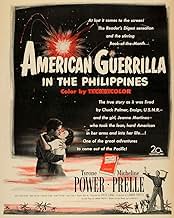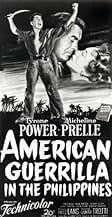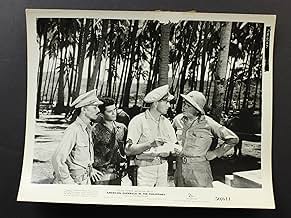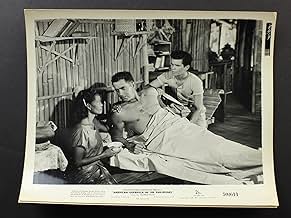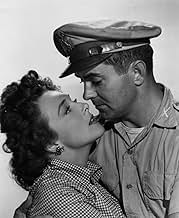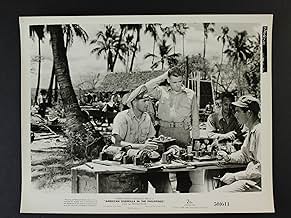PUNTUACIÓN EN IMDb
5,9/10
1,4 mil
TU PUNTUACIÓN
Los soldados estadounidenses varados en Filipinas después de la invasión japonesa forman bandas guerrilleras para contraatacar.Los soldados estadounidenses varados en Filipinas después de la invasión japonesa forman bandas guerrilleras para contraatacar.Los soldados estadounidenses varados en Filipinas después de la invasión japonesa forman bandas guerrilleras para contraatacar.
Micheline Presle
- Jeanne Martinez
- (as Micheline Prelle)
Robert Patten
- Lovejoy
- (as Bob Patten)
Miguel Anzures
- Native Traitor
- (sin acreditar)
Sabu Camacho
- Bo
- (sin acreditar)
Erlinda Cortes
- Partisan
- (sin acreditar)
Cris de Vera
- Japanese Officer
- (sin acreditar)
Rosa Del Rosario
- Partisan
- (sin acreditar)
Maria del Val
- Señora Martinez - the Aunt
- (sin acreditar)
Vic Diaz
- Japanese General
- (sin acreditar)
Arling Gonzales
- Radio Operator
- (sin acreditar)
Fred Gonzales
- Radio Operator
- (sin acreditar)
Eddie Infante
- Col. Dimalanta
- (sin acreditar)
Argumento
¿Sabías que...?
- CuriosidadesThis movie was filmed just prior to the outbreak of the Korean War in June of 1950, and used American warships to portray Japanese ships. One such ship, the U.S.S. Orleck (DD 886), exists to this day after serving in the Korean War, the Vietnam War and being sold for a while to the Turkish Navy, and is permanently docked in Lake Charles, LA, where it serves as a museum.
- PifiasWhen setting the sail early in the movie, Power's character refers to a halyard as a sheet. No real sailor would make such an error.
- ConexionesEdited into All This and World War II (1976)
Reseña destacada
There were hundreds of these cheap-ish World War Two quickies in the decade following the close of the conflict itself. They differed little from those produced during the war, still being in a kind of adulatory propagandistic mode, except that they were a little more vague usually having no direct message. What's more, as more time went by the seemed to get further and further from the realities of the conflict.
An American Guerrilla in the Philippines sees Tyrone Power, swashbuckling idol of the pre-war years, as an officer battling Japs in the Philippine jungle. Power has matured as an actor since his pictures a decade earlier, appearing tougher and less boyish, although he has also become less interesting in the process. His performance is steady and natural, but he is unable to make anything of what is admittedly a rather bland character on paper anyway. His buddy Tom Ewell is an unusual addition to the cast. He was in later years a very fine comedy actor, but it's hard to tell if he's appearing here as comic relief or not. In some moments, such as his burbling in the water trying to stay afloat, seem as if he is trying to play them for laughs, inappropriately if so, and certainly not at all funny. The rest of the cast is simply plain bad or plain boring.
Director Fritz Lang is normally someone who can give a nice baroque touch to even the most American of film formats, while still remain true to genre and tone. He seems uncertain however quite what to do with this one. He gives many shots in the jungle an abstract feel, with no familiar points of reference, giving them a threateningly wild look. Often his camera takes a spectator's position, peeping out through foliage. It's hard to tell what purpose this serves, as it distances us from the events on screen. Incidentally, Lang was a very good director of crowds and action, as evidenced in his big-budget silent pictures. There are some very powerful moments, with characters moving straight towards us down the middle of the shot and memorably stylised movements. However for a director who is normally so good at imbuing his work with a dark and nightmarish feel, An American Guerrilla in the Philippines has none of the bleak terror of, say, Operation Burma, a picture which really worked because it made us the audience feel lost within the jungle ourselves.
And ultimately An American Guerrilla in the Philippines is too light, and too sparing on any true sense of tragedy. It's lack of a real feeling of danger gives it many dull stretches, and its lack of realism does a disservice to those involved in the conflict. All of which is rather odd because the picture is also far from being a comedy. The only thing which saves it and makes it watchable is Fritz Lang's strong, vibrant imagery, such as dozens of hats waving in the air or a soldier's dying scream just inches from the lens. Having said that, there are far better Fritz Lang pictures to see these brilliant touches in.
An American Guerrilla in the Philippines sees Tyrone Power, swashbuckling idol of the pre-war years, as an officer battling Japs in the Philippine jungle. Power has matured as an actor since his pictures a decade earlier, appearing tougher and less boyish, although he has also become less interesting in the process. His performance is steady and natural, but he is unable to make anything of what is admittedly a rather bland character on paper anyway. His buddy Tom Ewell is an unusual addition to the cast. He was in later years a very fine comedy actor, but it's hard to tell if he's appearing here as comic relief or not. In some moments, such as his burbling in the water trying to stay afloat, seem as if he is trying to play them for laughs, inappropriately if so, and certainly not at all funny. The rest of the cast is simply plain bad or plain boring.
Director Fritz Lang is normally someone who can give a nice baroque touch to even the most American of film formats, while still remain true to genre and tone. He seems uncertain however quite what to do with this one. He gives many shots in the jungle an abstract feel, with no familiar points of reference, giving them a threateningly wild look. Often his camera takes a spectator's position, peeping out through foliage. It's hard to tell what purpose this serves, as it distances us from the events on screen. Incidentally, Lang was a very good director of crowds and action, as evidenced in his big-budget silent pictures. There are some very powerful moments, with characters moving straight towards us down the middle of the shot and memorably stylised movements. However for a director who is normally so good at imbuing his work with a dark and nightmarish feel, An American Guerrilla in the Philippines has none of the bleak terror of, say, Operation Burma, a picture which really worked because it made us the audience feel lost within the jungle ourselves.
And ultimately An American Guerrilla in the Philippines is too light, and too sparing on any true sense of tragedy. It's lack of a real feeling of danger gives it many dull stretches, and its lack of realism does a disservice to those involved in the conflict. All of which is rather odd because the picture is also far from being a comedy. The only thing which saves it and makes it watchable is Fritz Lang's strong, vibrant imagery, such as dozens of hats waving in the air or a soldier's dying scream just inches from the lens. Having said that, there are far better Fritz Lang pictures to see these brilliant touches in.
- Steffi_P
- 20 nov 2010
- Enlace permanente
Selecciones populares
Inicia sesión para calificar y añadir a tu lista para recibir recomendaciones personalizadas
- How long is American Guerrilla in the Philippines?Con tecnología de Alexa
Detalles
- Duración1 hora 45 minutos
- Relación de aspecto
- 1.37 : 1
Contribuir a esta página
Sugerir un cambio o añadir el contenido que falta

Principal laguna de datos
By what name was Guerrilleros en Filipinas (1950) officially released in India in English?
Responde
